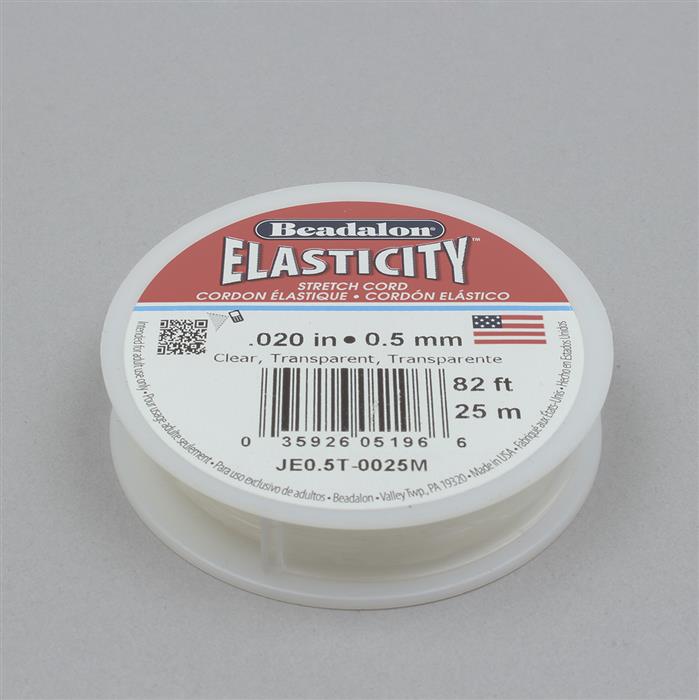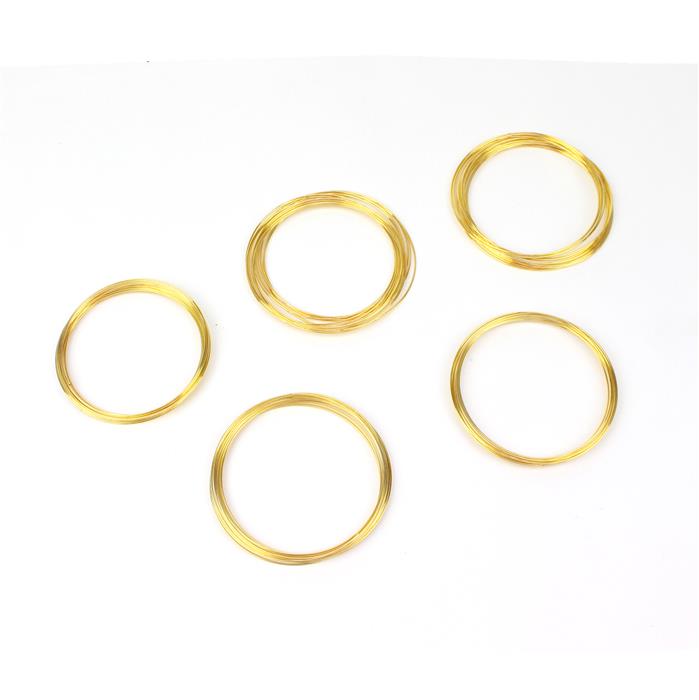A Guide to Different Threading Materials for Jewellery Making
Hey there, jewellery makers! Today, let's talk about one of the most crucial elements of jewellery making - threading materials. From bracelets and necklaces to earrings and anklets, the right threading material can make all the difference in the durability, design, and overall look of your jewellery.
With so many different types of threading materials available, it can be overwhelming to decide which one is best suited for your project. That's where we come in! As your trusty guide to all things jewellery making, we're here to help you navigate through the world of threading materials and find the perfect one for your masterpiece.
Take a look at our threading materials here:
Shop Threading Materials
So, grab your cup of tea (or coffee) and let's dive into the wonderful world of threading materials!
Elastic Stretch Cord
Elastic stretch cord is used for making stretchy jewellery such as bracelets and necklaces, it is naturally waterproof and won't fray making it ideal for a beginner jewellery maker.
How to use: Simply cut to size, thread on the beads then fasten it using a double knot (surgeons knot/Reef knot) and add a dab of glue or clear nail polish.

Memory Wire
Memory wire is a pre-coiled hardened steel wire that springs back into shape after it has been manipulated. Available in Ring, Bracelet and Necklace sizes these are a great way to create jewellery quickly.
How to use: Cut to size using specific Memory Wire Cutters (warning: this hardened wire will blunt standard jewellery cutters or flush cutters), thread on your beads and create loops at either end to secure the beads in place. Memory Wire End Caps are also available though not essential and are secured with glue.

Beading Wire / Tiger Tail
Beading Wire or Tiger Tail is thin braided stainless-steel wire that has been coated with Nylon, it is very strong and flexible and is ideal for making necklaces or bracelets, an essential part of any jewellery maker's kit.
How to use: Simply cut to size, thread on the beads and use Crimp beads to secure findings such as a clasp and jump ring to the ends.

Flex-Rite
Flex-Rite uses micro wire technology to form a strong, soft and kink resistant flexibility, it is comprised of multiple stainless-steel wires braided together and coated in Nylon. It is also available in Sterling Silver making it the go to thread for professional jewellers.
How to use: Simply cut to size, thread on the beads and use Crimp beads to secure findings such as a clasp and jump ring to the ends.
FireLine
FireLine is a synthetic pre-waxed braided bead cord consisting of gel-spun polyethylene. It is stretch and fray resistant and very strong. It is available in Crystal, Black, Smoke and Satin Black. It will fit an English beading needle size 10 or 12.
How to use: Used with a Beading Needle this thread is ideal for Seed Beading, Loom work and Bead Embroidery projects.

WildFire
WildFire is thermally bonded thread said to be pierce resistant, has minimal stretch and won't fray. It comes in a variety of colours including, black, white, blue, red, grey and green and will fit an English Beading Needle size 10 or 12 if you flatten the end with your fingernails first.
How to use: Used with a Beading Needle this thread is ideal for Seed Beading, Loom work and Bead Embroidery projects.

Illusion Cord/Monofilament
Monofilament or Illusion cord is a single continuous length of synthetic (Nylon) fiber, it is very strong, snag resistant and transparent meaning you can create designs that appear to float in mid air.
How to use: Used to create Illusion necklaces with a floating appearance, just cut to size and thread beads on without requiring a needle. It can be tied together with a Surgeon’s or Reef knot and a dab of glue. It can also be crimped but this runs a risk of cutting through the cord with the metal edge of the crimp bead.

Nylon Cords/S-Lon/C-Lon/Superlon
Nylon beading thread comes in a selection of sizes and all colours of the rainbow. It’s a twisted multifilament and lightly waxed making it great for beading and loom work, and the thicker gauges are ideal for knotting and braiding in techniques such as Macrame & Kumihimo. S-Lon, C-Lon and Superlon are the same thing under different names. (C-Lon comes in slightly larger spools with more yardage but the colours and gauges are the same).
How to use: Different gauges of cord are used for different projects, check out our handy Cord Guide to help you select the right one for your project. Popular uses of Nylon cord include Macrame Friendship Bracelets, Wall Art, Gemstone Knotting and Kumihimo Braiding.

Nymo Cord
Nymo beading thread is a pre-waxed nylon filament available in lots of lovely colours and unlike the others is not twisted. It works really well as the weft cord in loom weaving and is also ideal for creating fringes and tassels due to it’s fluid like movement. It is a useful thread for stitched projects and Seed Beading
How to use: Used with a beading needle or on a loom, you stitch small glass beads together to create intricate patterns, alternatively you can use it to create a fringe from a Brick stitched base to make dangly earrings or tassels.

Satin Cord/Rattail
Satin cord also known as Rattail is a thicker silky thread that comes in a rainbow of colours. It’s great for Macrame, Chinese Style Knotting, Kumihimo Braiding and on its own as a threading material for beads with a larger drill hole
How to use: Cut to size and thread on your chosen beads, secure the ends by knotting or using Cord End Findings. Alternatively use a Kumihimo Disk and create a gorgeous silky braid bracelet.

Waxed Cord
Waxed Cord is often made in 3 or 4 ply cotton with a beeswax coating. The wax make the cords more water resistant and durable, so it allows it to pass through beads more smoothly. This type of thread is used for stringing necklaces with pendants, Macrame and homewares.
How to use: Cut to size, thread on your chosen beads and finish either by knotting and a dab of glue or use cord endings in the size that fits the cord you’re using.

Hemp Cord
Hemp cord is made from the outer tough fibers of the cannabis plant, they are twisted and woven together into a yarn which can then be used for clothing, jewellery, garden twine and even toys for dogs. It has an earthy rustic look often a light brown/natural colour, but it can be dyed for brighter colours
How to use: Cut to size and thread on your chosen beads then knot to finish. This is an ideal cord for Macrame and simple rustic knotted bracelets.

Silk
Made from harvesting the cocoons of Silk Moths the natural silk fibers are soaked and unwound to then spin together into yarn. Naturally glossy this superior thread is used in textiles but is also used for Knotting Pearls to make jewellery.
How to use: Using a traditional method of Pearl Knotting add on each individual pearl and create a small knot before adding the next. Use wire guardians or French wire to protect the silk from friction and fraying when attaching clasps.

Leather cord
Leather cords are great for making unisex jewellery, available as round, flat, braided. There are also alternative versions that look the similar but are made from PVC or Polyester.
How to use: Make a simple bracelet with spacer beads and sliding knots to finish.

And there you have it, my jewellery making friends! A guide to different threading materials for your jewellery making projects. We've covered everything from traditional favourites like cotton and silk to more unconventional options like nylon and wire.
Remember, the right threading material can make or break your jewellery design, so always choose wisely based on your project's requirements. Whether you're a seasoned pro or a newbie in the world of jewellery making, experimenting with different threading materials can add a whole new dimension to your creations.
We hope this guide has been helpful in expanding your knowledge of different threading materials and their unique properties. Now, go forth and create some stunning jewellery pieces! Don't forget to share your creations with us on our socials! As always, happy jewellery making!
Don't forget to take a look at the threading materials on our website!
Shop Threading Materials
JM

